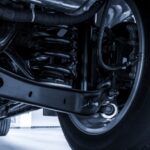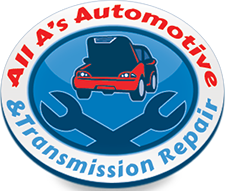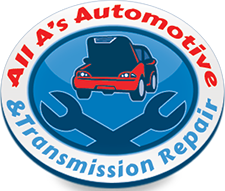What Does My Car’s Suspension System Really Do?

 Understanding your car’s suspension system can help improve your ride quality and reduce unnecessary repairs. Quickly spotting an automotive issue can prevent additional damage to companion parts. This philosophy is especially valid in your car’s suspension system. All of the components work together – and when one fails, the other parts take on more stress and strain. Don’t jeopardize your vehicle safety if you suspect an issue with your springs or shock absorbers in your suspension system. Please keep reading for more information on suspension parts, their role in vehicle safety, and how to spot warning signs when they fail.
Understanding your car’s suspension system can help improve your ride quality and reduce unnecessary repairs. Quickly spotting an automotive issue can prevent additional damage to companion parts. This philosophy is especially valid in your car’s suspension system. All of the components work together – and when one fails, the other parts take on more stress and strain. Don’t jeopardize your vehicle safety if you suspect an issue with your springs or shock absorbers in your suspension system. Please keep reading for more information on suspension parts, their role in vehicle safety, and how to spot warning signs when they fail.
What Does The Suspension System Do?
The suspension system helps absorb movement from the wheels while stabilizing the car’s frame. This helps make the driver more comfortable and provides sufficient steering and handling, even over rough roads. How does that work? Let’s review the components that make up most suspension systems and enhance vehicle safety.
Suspension System Components
A well-maintained suspension system allows you to safely and comfortably drive your car. If you experience excessive bouncing, traction problems, or unusual noises, one of the following components may need service or replacement. It’s good to note that not every vehicle has all these components, but the following list covers the most common parts in use today. Read your owner’s manual or consult your local auto shop for information on your specific car.
Coil Springs
Coil springs absorb the wheel’s motion, reducing impacts when your car drives over bumps. They help provide a smooth and comfortable ride for the motorist.
Leaf Springs
Leaf springs consist of numerous layers of metal strips (or “leaves”) bound together to perform as one unit. This component was utilized on older makes and model vehicles due to its easy assembly. Some truck models and heavy-duty equipment still use leaf springs.
Shock Absorbers
These components work with the coil springs and help damper impact motions. Shock absorbers also ensure that tires are in constant contact with the road.
Struts
Struts are structural parts of the suspension. They often combine several suspension parts into one assembly, which may include shocks and springs.
Sway Bars
Sway bars (or anti-roll bars) work with shock absorbers or struts to provide additional stability. A sway bar consists of a metal rod that spans the axle and joins the sides of the suspension together. So, when one wheel moves up and down, the sway bar transfers that movement to the opposite wheel. This component provides a more comfortable ride by limiting vehicle roll at its corners.
Control Arms
Control arms connect your car’s frame to the steering knuckle or wheel-hub assembly. They help the tires maintain road contact by moving up and down with the springs over bumps or uneven surfaces.
Ball Joints
Ball joints allow the vehicle to turn left and right. They also assist the control arms perform a smooth up-and-down motion.
Frame
The frame is considered a significant part of your vehicle’s suspension system. The rigid structure supports your vehicle’s weight and attaches to other suspension components.
Different Suspension System Types
Vehicles use different suspension system types, depending on their design and use. Both dependent and independent suspensions help maintain vehicle safety and stability.
Dependent Suspension
A dependent suspicion type utilizes rigid axles that span the width of the car’s frame to connect the two front wheels or the two back wheels. This suspension system is very effective on heavy-load vehicles or over rough terrain because the wheels work together, sharing the load.
Independent Suspension
With an independent suspension, each wheel has its own suspension assembly and moves individually without impacting the other wheels. This system offers a smooth ride and is common in modern passenger vehicles.
Suspension System Warning Signs
Different areas of the suspension system will wear out over time or become damaged. It’s important to notice signs that a part needs repairing or replacing. Some common signs of suspension damage include:
- Car pulls to one side: Drifting or pulling to one side may indicate the shocks require replacement.
- Clunking or knocking noises: If you hear noises when driving over bumps or other road imperfections, your vehicle may need new shocks or springs.
- Rough ride: Damaged suspension parts can result in a rough ride while driving due to bumps, dips, and other uneven road surfaces.
- Sagging corner: A worn-out or damaged spring can cause your vehicle to sag towards the ground.
- Shaking or Vibrating: Vibrations felt through the steering wheel often signal problems with the suspension system.
- Uneven tire tread wear: Irregular tire tread wear can help identify many suspension, wheel imbalance, and alignment issues.
Routine Maintenance = Vehicle Safety
To maintain your car’s suspension, regularly inspect components for wear or damage and replace them without delay. Let All A’s Automotive assist you with your vehicle’s routine maintenance schedules. Our trained service technicians provide full suspension system service for foreign and domestic automobiles. We can inspect your car’s shock absorbers, springs, and other suspension parts to restore vehicle safety.
Schedule A Suspension System Service
Call the team at All A’s Automotive & Transmission Repair at (989) 631-4672 or visit our website today!
Posted in: Suspension System
Leave a Comment (0) ↓
